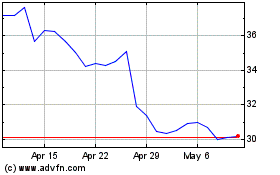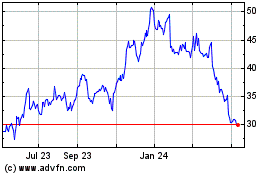Intel CEO Search Follows Other Executive Exits -- WSJ
June 22 2018 - 3:02AM
Dow Jones News
By Tripp Mickle
This article is being republished as part of our daily
reproduction of WSJ.com articles that also appeared in the U.S.
print edition of The Wall Street Journal (June 22, 2018).
The sudden exit of Intel Corp. Chief Executive Brian Krzanich
for violating company policy is the latest in a string of
high-level departures at the chip giant.
Diane Bryant, former head of Intel's data-center group, joined
Google's cloud business late last year, while Kirk Skaugen, former
head of client computing who was at one point seen as a CEO
candidate, left the company in 2016 and is now with Lenovo
Group.
"Given so much change driven by Mr. Krzanich, his departure
could make succession planning and further transition challenging,"
analysts at Cowen & Co. said Thursday. The transition comes as
it seeks to extend its dominance in PC chips into new frontiers in
computing.
Two current Intel executives -- Venkata M. Renduchintala, known
as Murthy, and Navin Shenoy -- are believed to have the inside
track among internal candidates to succeed Mr. Krzanich, according
to people familiar with the company's leadership.
Dr. Renduchintala, who previously worked at Qualcomm Inc., is
Intel's engineering chief, overseeing development of traditional
processors and the company's coming graphics chips. He recently
took responsibility for manufacturing operations, which have been
plagued with delays in producing the company's next-generation
chips.
Mr. Shenoy currently oversees Intel's high-margin data-center
business, and before that ran its PC business -- Intel's most
dominant areas -- which both showed improved performance under his
leadership, the people said.
Intel's strength in processing chips has come under pressure as
graphics processors, primarily from Nvidia Corp., emerged as a
workhorse for artificial intelligence. Intel in 2016 sought to
address that market by buying Nervana Systems and Movidius, a pair
of startups working on AI-focused chips. It recently launched an
effort to make graphics chips to better compete with Nvidia.
Intel became more acquisitive under Mr. Krzanich. He built out
Intel's business in data-center servers, supplying companies such
as Amazon.com Inc. and Microsoft Corp. that are spending billions
annually on cloud-computing facilities. A big chunk of that growth
came from Intel's $16.7 billion deal for Altera Corp. in 2015 --
the company's biggest-ever acquisition.
Mr. Krzanich followed up his Altera buy with a big bet on the
booming market for automotive-vehicle technology by spending $15.3
billion for Mobileye NV, a leader in sensors for assisted-driving
features.
Mr. Krzanich also sought growth in others areas, beefing up
Intel's position in outfitting a variety of household and
industrial equipment with computing capabilities, a burgeoning
business known as the Internet of Things. Intel has made a push in
the market for cellular-communications chips, replacing Qualcomm
Inc. units in a portion of Apple Inc.'s iPhones, and has made
inroads on 5G cellular technology.
Mr. Krzanich pushed Intel into visibly high-profile areas such
as augmented-reality headsets and competitive gaming known as
esports. Some of these efforts fell short; the company, for
instance, shut down several products designed for wearable
computing, such as smartwatches.
Since Mr. Krzanich was named CEO in May 2013, Intel's share
price has risen 123%, outpacing the S&P 500 but underperforming
the PHLX Semiconductor Sector Index. Sales have grown nearly 18%
between 2012 and 2018 to $62.76 billion. Last year, Intel held a
99% share of the most popular type of chips used in servers, and a
91% share of the processors found in PCs, according to Mercury
Research.
Write to Tripp Mickle at Tripp.Mickle@wsj.com
(END) Dow Jones Newswires
June 22, 2018 02:47 ET (06:47 GMT)
Copyright (c) 2018 Dow Jones & Company, Inc.
Intel (NASDAQ:INTC)
Historical Stock Chart
From Mar 2024 to Apr 2024

Intel (NASDAQ:INTC)
Historical Stock Chart
From Apr 2023 to Apr 2024
